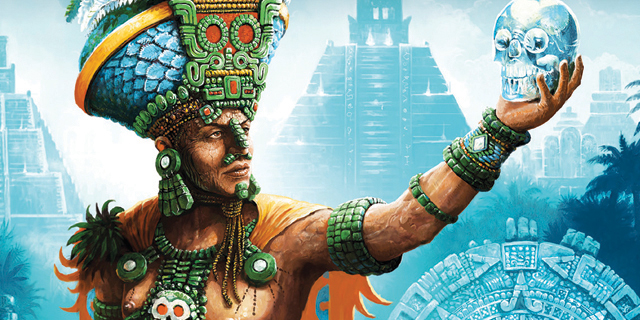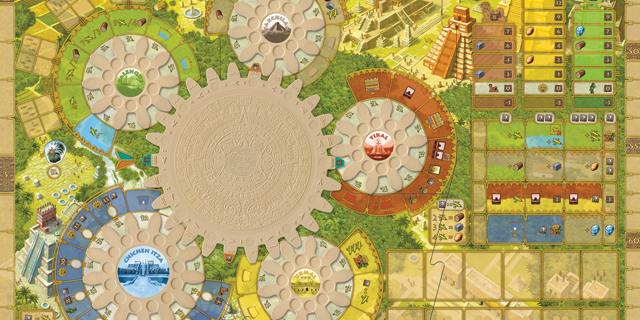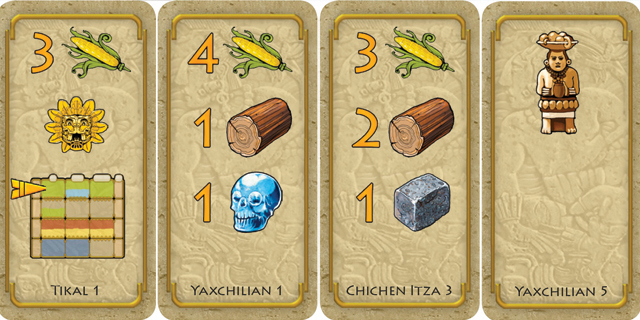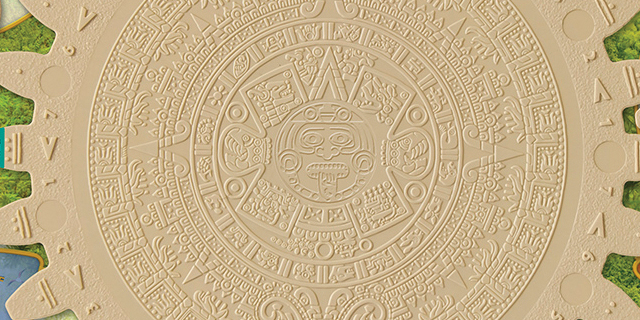
The whole “Mayan Calendar” doomsday scenario of late 2012 was an amusing, if ultimately pointless, event that will largely vanish into memory as time passes. For board game fans, however, it will forever be immortalized by the brilliant Tzolk’in: The Mayan Calendar, designed by Italian Daniele Tascani with help from fellow countryman Simone Luciani. Tzolk’in appeared on a truly impressive number of year’s best lists from late 2012 to early 2014, winning a half-dozen awards and nominated for at least twice as many more in that span.
While Tzolk’in takes several tried-and-true mechanics and mixes them together into a strategic whole, it is its dynamic take on worker placement that everyone remembers first and foremost. Also, the fact that said worker placement happens on giant plastic gears gives it both a unique visual look and a ready-made nickname (“that gear game”). There are six such gears, a giant central one divided into four quarters and five smaller gears attached to it.
Each turn, a player must either place or retrieve one or more workers, but cannot do both. Workers are placed on the smaller gears with costs in corn corresponding to their locations and how many additional workers that player has placed that turn. Retrieved workers earn the benefit of their current location on their gear, which will depend on how many turns have passed since they were placed. They may instead use the benefit of any space they have passed, for the additional cost of one corn per space back.

After each player has executed an action for a round, the start player rotates the central gear one mark. This in turn advances each of the smaller gears and any workers on them one space as well. It is possible for a neglected worker to move past the final space on their gear, at which point it is lost. Additionally, there is one non-gear space on which a single worker can be placed. Whoever does so becomes the start player, earns corn equal to the number of turns since the last time someone used this space and has the (usually) one-time option of turning the center gear two spaces. This is a powerful ability and can really accelerate — or mess with — everyone’s plans, so use it wisely.
The five small gears represent different areas of Mayan culture. The green track gains players wood or corn, while the brown track provides wood, stone, gold and crystal skulls. The red track allows players to convert resources into either buildings, temples or advancements in technology (like agriculture). Crystal skulls can be placed on the blue track for massive points and favor of one of the three gods. Finally, the yellow track lets players use corn to purchase a grab bag of other effects. Temples and the gods are the two main sources of points, so be sure to have those goals in mind while collecting resources.

When the central gear passes one of its quarter markers, players must provide two corn to each active worker they possess or lose three points per worker they could not satisfy. Corn is so vital to this game, acting as both food and a basic currency, that there is even an option to “beg” for corn at the cost of some of your hard-earned favor. You can only use this if you start your turn with fewer than three pieces, but it might be better than being able to do next to nothing. The game ends following the fourth feeding day.
A game of Tzolk’in will take about 90 minutes once everyone knows what they’re doing. That said, this is one of the most brain-burning games I’ve played in some time, as you have to plan moves several turns in advance to make sure your workers are where you need them to be at the right time. Expect your first few games to take longer, probably up to two full hours, as there are literally a lot of moving parts here.
Tzolk’in keeps games interesting by introducing two elements of randomness in set-up. Firstly, the specific monuments available to players are selected at random from the available pool. Which monuments are actually out there will enable certain strategies and make others less viable. Monuments aren’t strictly necessary to score well, but the right ones can be worth a large stack of points at the end of the game.

The other factor are the four “wealth” tiles dealt out to each player, of which they get to select and keep two. These tiles will determine what resources each player will receive at the start of the game, as well as possibly providing other benefits. Which wealth tiles you keep will have a dramatic impact on your plans. Of course, this becomes easier as you gain more experience with the game and recognize its various paths to victory.
Interestingly, the wealth tiles that aren’t dealt out also have a function: they indicate where “dummy” workers are placed when playing with fewer than four players. These “dummies” occupy spaces on the gears, making those spaces unavailable to the players. As this is less than ideal when it comes to strategy, it is recommended to always play Tzolk’in with four players whenever possible although learning games with fewer are probably fine.
As I mentioned, Tzolk’in is as advanced as board games come without delving into wargaming. The kind of player who enjoys this type of game will really enjoy Tzolk’in, but more casual players will most likely be lost. Know your audience here and you’ll reap rewards. (Also: corn.)
Tzolk’in: the Mayan Calendar retails for $60.



















